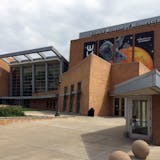The Big Bend project planned for southern Minnesota would be one of the state's biggest wind farms, and paired with a large solar plant, would be different from any other power project in the state.
But Big Bend's proximity to the Jeffers Petroglyphs site — sacred to Indigenous people — has alarmed the state's historic preservation office and the Lower Sioux Indian Community.
"I just want to emphasize that to the Lower Sioux this project is considered a high priority," Cheyanne St. John, the tribe's historic preservation officer, told Minnesota utility regulators Thursday. "This site is highly significant to the Upper Sioux and Lower Sioux (communities), but also to tribes that are out of state as far as Missouri."
The Minnesota Public Utilities Commission (PUC) on Thursday accepted Big Bend's application for review, but the Jeffers Petroglyphs issue will get special scrutiny before any approval of the project.
The Jeffers Petroglyphs, near Comfrey, Minn., are a collection of about 5,000 rock carvings listed on the National Register of Historic Places. The carvings date back 7,000 years and are considered sacred to tribal nations, including the Dakota, Cheyenne, Ioway and Ojibwe.
Tribal members "actively continue to pray and hold ceremonies [at the petroglyphs], as their ancestors have done for thousands of years," the Minnesota Historical Society said in a PUC filing.
The Big Bend project, which is being developed by Apex Clean Energy Holdings, would entail about 55 wind turbines that could produce up to 308 megawatts of electricity.
Big Bend is linked to Apex's nearby Red Rock solar project, which would have up to 60 megawatts of power production capacity.


